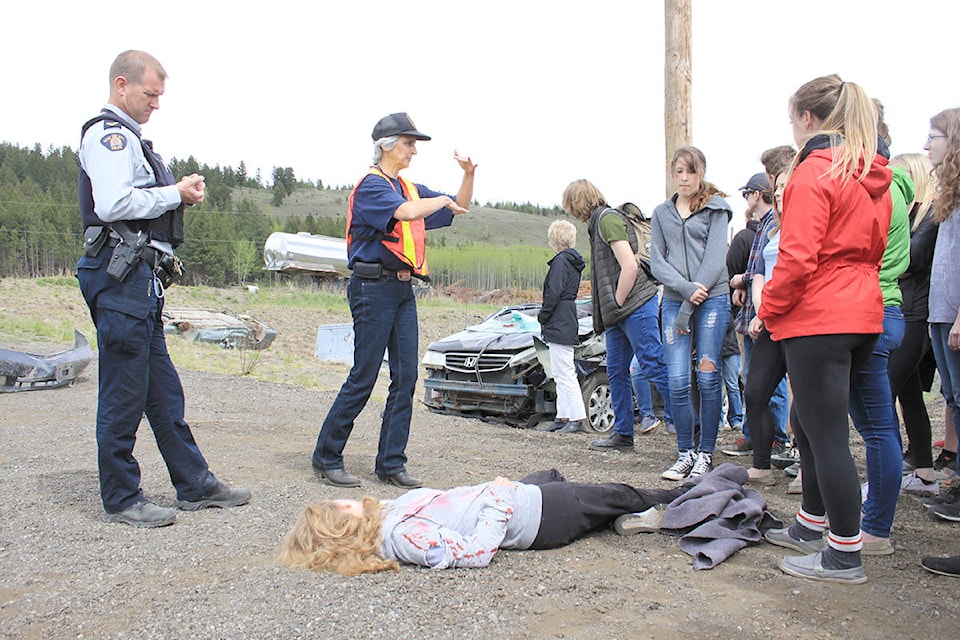Grade 10 students from Peter Skene Ogden Secondary School (PSO) spent the day at the Emergency Services Training Centre on Exeter-McKinley Road on May 9 learning from first responders who arrive and work on accident scenes as part of the P.A.R.T.Y. program.
“I think it went as well as it could be but we had a rather massive change of plans when our emergency responders were called out to two callouts within five minutes of each other. Those things happen so we had to sort of fly by with the seat of our pants and put a scenario together that would still work,” said Laura Dewar, the facilitator of the South Cariboo P.A.R.T.Y. (Prevent Alcohol and Risk-Related Trauma in Youth) program.
Dewar, who used to be a coroner, and the first responders provided lectures from 9 a.m. to lunchtime.
After lunch, the students were shown a full mock accident including the initial response, clean-up and what happens at the hospital, and the morgue.
The program is geared to Grade 10 students because they are at the age where they are beginning to drive or have already started and become more independent.
“So they are reaching an age where you can’t tell them what to do, you have to just say “look if you choose to for example; drive impaired, skateboard without a helmet, drive without a seatbelt, get in a vehicle with an impaired driver - these are the things that can happen to you,” she said.
The morning segment has survivors from impaired driving incidents, as well as parents who have lost a child to a similar accident or overdosing at parties present.
Consequences for holding a party, such as a wet grad, where someone gets hurt were also brought up.
“If something happens to a young person, whether it is an alcohol overdose at the house or someone manages to sneak out and is badly injured or worse, I don’t think they realize they [party hosts] can lose everything,” said Dewar.
The program used to have lawyers come to the event to talk about the legal consequences.
People who host teen parties can face civil or criminal penalties depending on what happens or what they are found liable for.
In civil law, parents can be held responsible if injuries or losses occur at a party and parents have been found negligent in some way, this can happen even if the parents did not provide the alcohol or drugs but make no attempt to intervene or supervise.
Some lawsuits can take up to years but Dewar says one of the biggest consequences is living with the guilt someone might face if someone does get hurt or dies.
Students also get to participate in hands-on activities and simulations like wearing drunk goggles and trying to write and living with a severe brain injury.
Dewar said that she would say this type of learning experience is a lot more effective than the typical lecture in a classroom or other program.
“There’s even peer-reviewed research all over the world looking at the effectiveness of the P.A.R.T.Y. program versus not doing anything or having kids in other programs where they are just lectured to,” she said.
She said the most effective part of the day was probably Susan Fryer’s performance as a grieving mother in the mock crash scenario.
In the scenario, two young girls are involved in a driving accident where one of them dies on the scene and the other in the hospital. Fryer played the mother of the second girl when the doctor and RCMP officer break the news to her.
“She is so realistic, I can’t be in there. I have to go to another room because she makes me cry. She has nailed it in terms of what a mum sounds like when they come into the Emergency Room and see their son or daughter basically almost looking like a vegetable,” said Dewar. “It’s probably the most impactful part because we really want them [the students] to see how their actions also impact the people in the community.”
The program has been around since 1986 at Sunnybrook Hospital (in Toronto) because the nurses and doctors were getting frustrated with the amount of youth being admitted due to serious injuries that were very preventable, according to Dewar.
“If we just save one life, it’s worth it,” Dewar said about the program.
Like us on Facebook and follow us on Twitter.
